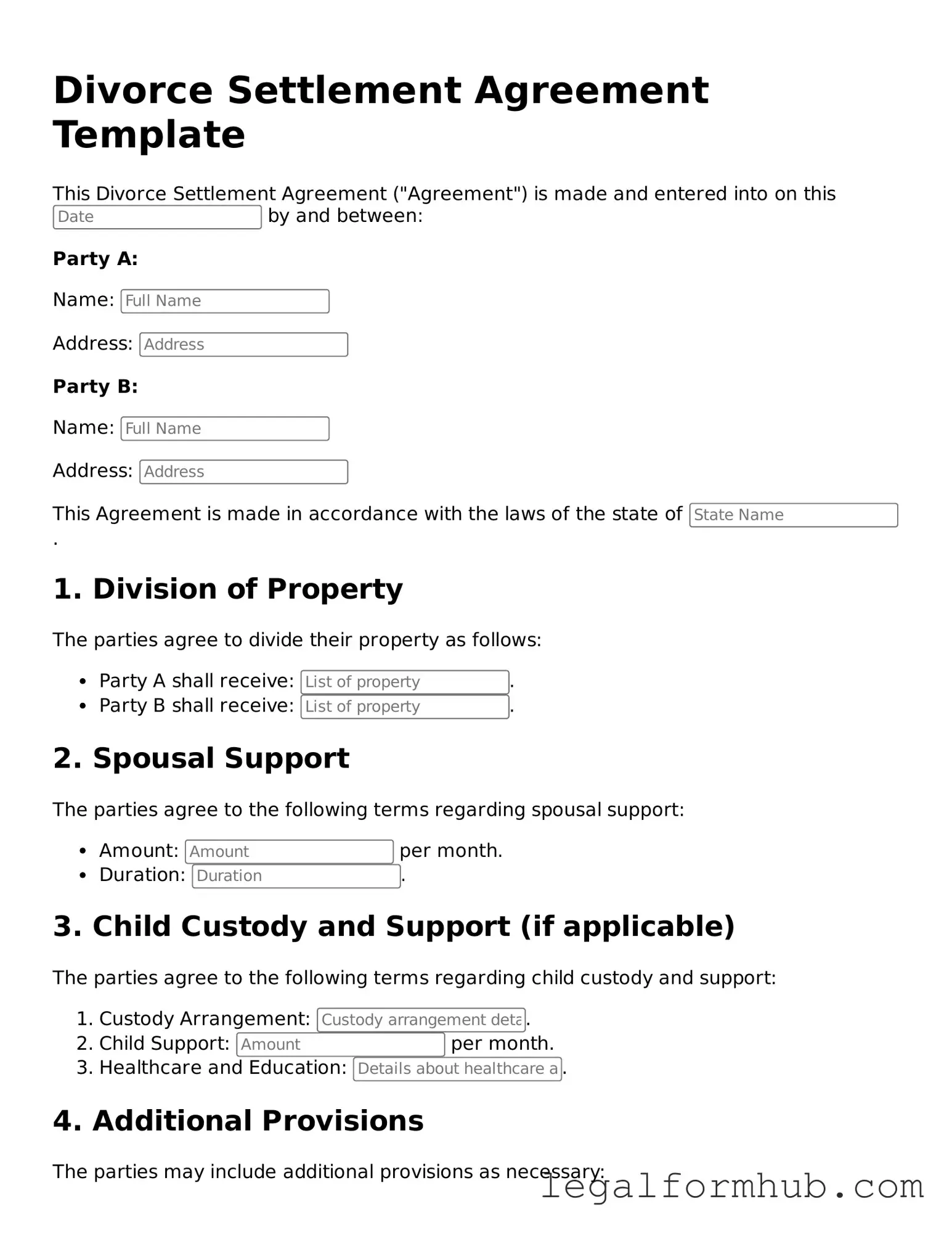The Divorce Settlement Agreement form shares similarities with a Separation Agreement. Both documents outline the terms and conditions under which a couple will separate, addressing issues such as property division, child custody, and support obligations. While a Divorce Settlement Agreement is typically finalized when the couple is ready to divorce, a Separation Agreement can be used when couples choose to live apart without immediately proceeding to divorce. This allows them to establish their rights and responsibilities during the separation period.
Another document akin to the Divorce Settlement Agreement is the Marital Settlement Agreement. This document is often used in divorce proceedings to detail the division of assets and debts, as well as arrangements for children. Like the Divorce Settlement Agreement, it aims to resolve disputes amicably and outline clear expectations for both parties. The key difference lies in the timing; the Marital Settlement Agreement is usually part of the divorce process, while the Divorce Settlement Agreement is specifically the final agreement reached post-negotiation.
A Child Custody Agreement is also similar, focusing primarily on the arrangements for children following a divorce or separation. This document specifies where the children will live, visitation rights, and how decisions regarding their upbringing will be made. While the Divorce Settlement Agreement encompasses broader issues, the Child Custody Agreement zeroes in on the well-being and care of children, ensuring that their needs are prioritized during and after the divorce.
The Parenting Plan is another related document. It is a detailed outline of how parents will raise their children after separation or divorce. This plan covers aspects like holiday schedules, communication methods, and conflict resolution strategies. While the Divorce Settlement Agreement may mention parenting arrangements, the Parenting Plan delves deeper into the logistics of co-parenting, making it an essential tool for divorced parents.
A Property Settlement Agreement is closely linked to the Divorce Settlement Agreement, as both deal with the division of marital assets and debts. This document specifically outlines how property will be divided between spouses, addressing both tangible assets like homes and vehicles, as well as intangible assets like retirement accounts. While the Divorce Settlement Agreement includes broader terms, the Property Settlement Agreement focuses solely on the financial aspects of the divorce.
For those seeking clarity on company policies and expectations, the important Employee Handbook guidelines can be incredibly valuable. This form facilitates a comprehensive understanding between employers and employees, reinforcing the importance of compliance with applicable regulations.
The Alimony Agreement is another document that complements the Divorce Settlement Agreement. This agreement specifies the terms of spousal support, including the amount and duration of payments. While the Divorce Settlement Agreement may include provisions for alimony, the Alimony Agreement provides a more detailed framework for financial support, ensuring that both parties understand their obligations and rights.
A Non-Disclosure Agreement (NDA) can also be relevant in the context of divorce. In some cases, spouses may wish to keep certain financial information or personal matters confidential during and after the divorce process. An NDA can protect sensitive information from being disclosed to third parties. While the Divorce Settlement Agreement outlines the terms of the divorce, an NDA specifically addresses confidentiality concerns, safeguarding the privacy of both parties.
The Prenuptial Agreement, although typically created before marriage, bears similarities to the Divorce Settlement Agreement in that it sets forth the terms of asset division in the event of a divorce. Both documents aim to protect the interests of each party and provide a clear framework for resolving financial matters. However, the Prenuptial Agreement is established before marriage, whereas the Divorce Settlement Agreement is created after the decision to divorce has been made.
Lastly, a Mediation Agreement is relevant in the divorce context. This document is the result of mediation, where a neutral third party helps couples negotiate the terms of their divorce. The Mediation Agreement outlines the agreements reached during mediation, which may then be formalized in a Divorce Settlement Agreement. Both documents serve to resolve disputes amicably, but the Mediation Agreement specifically reflects the collaborative process of negotiation rather than the final legal terms.
